Financial Analysis Report on Risk Management and Finance
VerifiedAdded on 2023/01/16
|28
|8621
|92
Report
AI Summary
This financial analysis report examines the construction project of St. Martin Hospital in San Francisco, focusing on risk management and finance. It explores the use of Enterprise Resource Planning (ERP) systems to improve project performance and increase profits. The report utilizes the Characteristics Analysis Method (CAM) and the Risk Analysis Method (RAM) to identify and assess critical risks. It covers technical aspects of ERP project risks, project control systems, and provides a detailed risk management plan. The report also analyzes financial aspects, including development plans, interpreting analyses and valuations, and interpreting appraisals. The report recommends a project control system that includes regular meetings, risk assessments, staff training, communication, and environment monitoring. This comprehensive analysis offers insights into managing risks and financial strategies within the construction project, providing valuable information for project management and finance professionals.
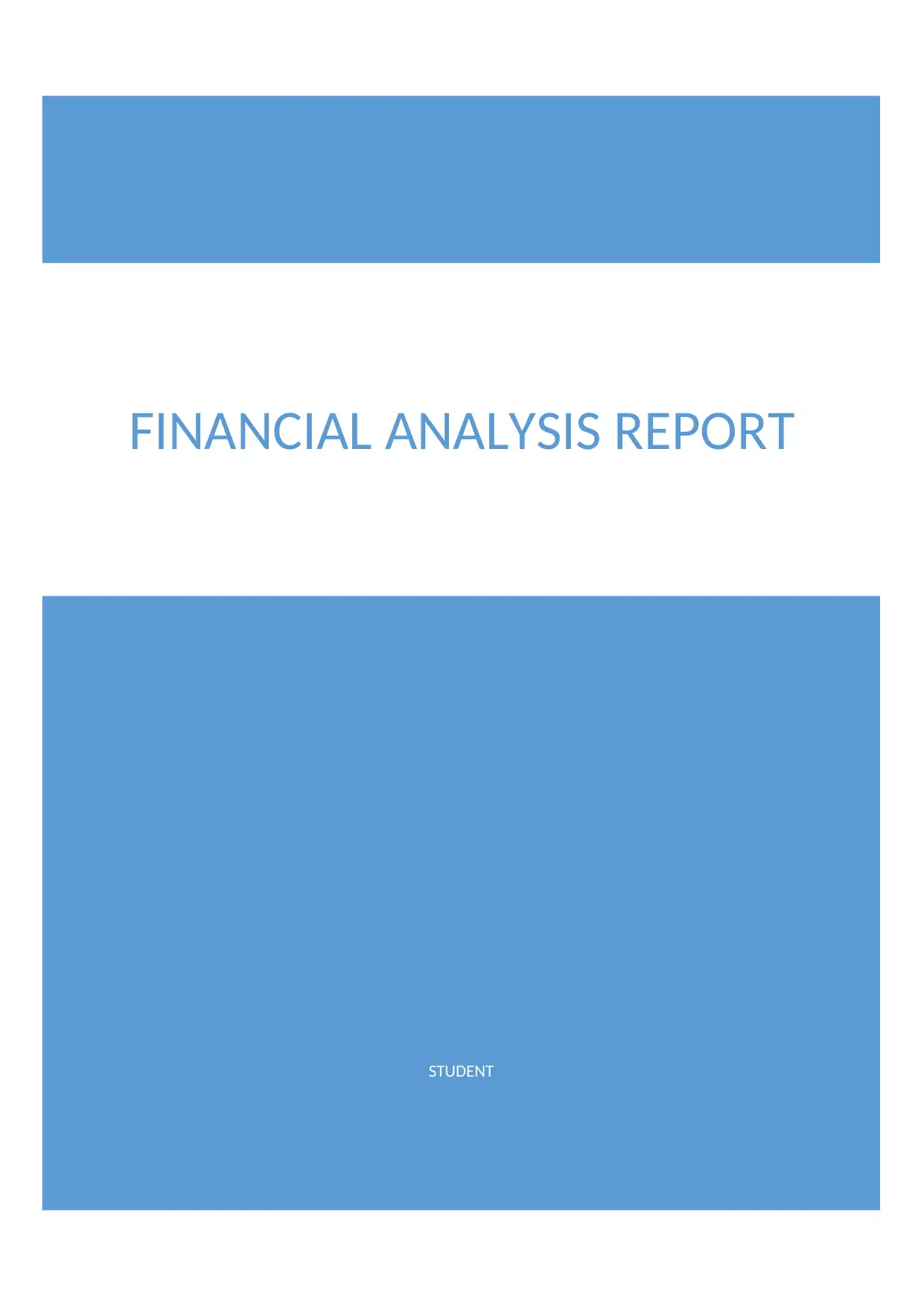
STUDENT
FINANCIAL ANALYSIS REPORT
FINANCIAL ANALYSIS REPORT
Paraphrase This Document
Need a fresh take? Get an instant paraphrase of this document with our AI Paraphraser
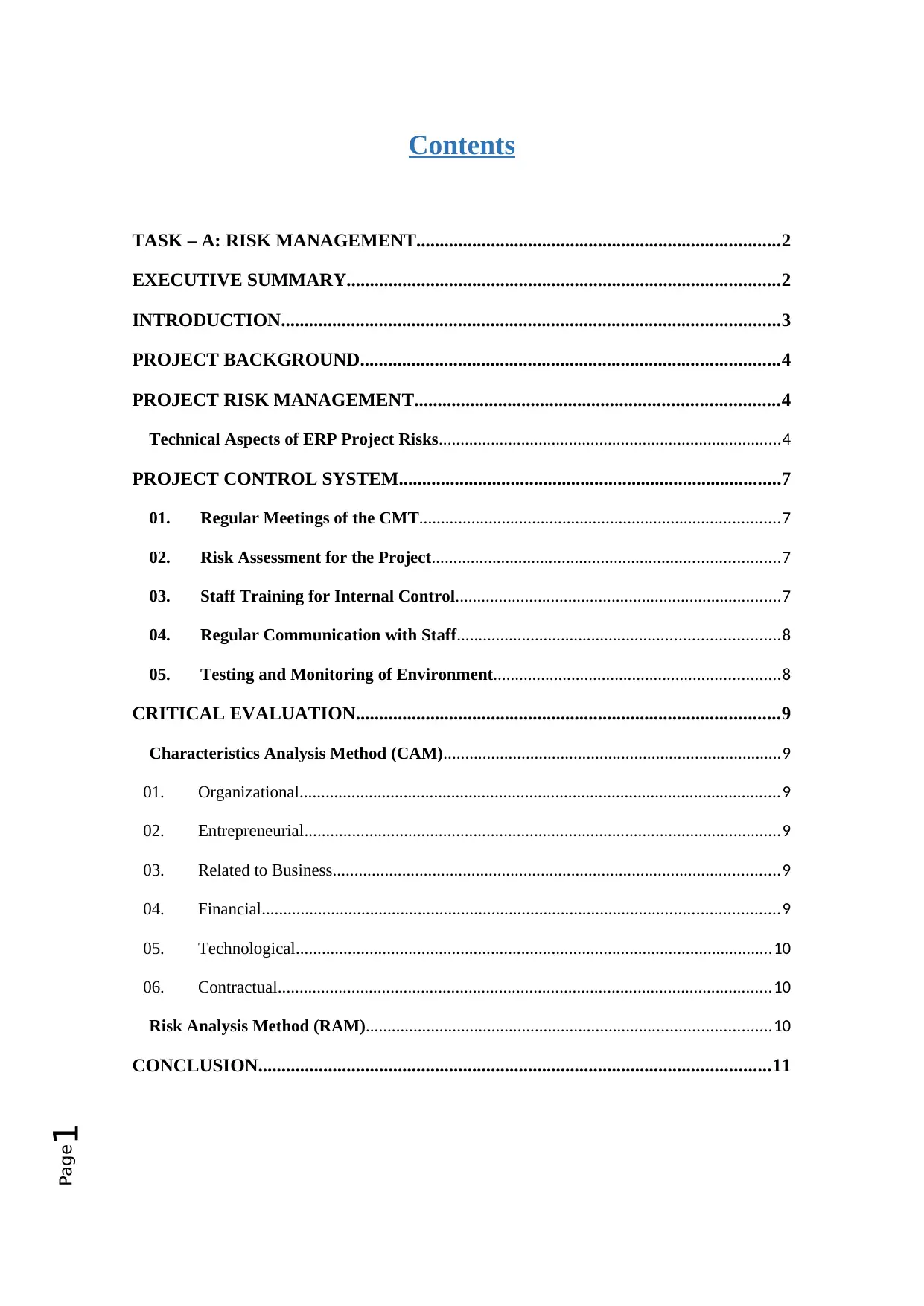
Page1
Contents
TASK – A: RISK MANAGEMENT..............................................................................2
EXECUTIVE SUMMARY.............................................................................................2
INTRODUCTION...........................................................................................................3
PROJECT BACKGROUND..........................................................................................4
PROJECT RISK MANAGEMENT..............................................................................4
Technical Aspects of ERP Project Risks...............................................................................4
PROJECT CONTROL SYSTEM..................................................................................7
01. Regular Meetings of the CMT...................................................................................7
02. Risk Assessment for the Project................................................................................7
03. Staff Training for Internal Control...........................................................................7
04. Regular Communication with Staff..........................................................................8
05. Testing and Monitoring of Environment..................................................................8
CRITICAL EVALUATION...........................................................................................9
Characteristics Analysis Method (CAM)..............................................................................9
01. Organizational...............................................................................................................9
02. Entrepreneurial..............................................................................................................9
03. Related to Business.......................................................................................................9
04. Financial.......................................................................................................................9
05. Technological..............................................................................................................10
06. Contractual..................................................................................................................10
Risk Analysis Method (RAM).............................................................................................10
CONCLUSION..............................................................................................................11
Contents
TASK – A: RISK MANAGEMENT..............................................................................2
EXECUTIVE SUMMARY.............................................................................................2
INTRODUCTION...........................................................................................................3
PROJECT BACKGROUND..........................................................................................4
PROJECT RISK MANAGEMENT..............................................................................4
Technical Aspects of ERP Project Risks...............................................................................4
PROJECT CONTROL SYSTEM..................................................................................7
01. Regular Meetings of the CMT...................................................................................7
02. Risk Assessment for the Project................................................................................7
03. Staff Training for Internal Control...........................................................................7
04. Regular Communication with Staff..........................................................................8
05. Testing and Monitoring of Environment..................................................................8
CRITICAL EVALUATION...........................................................................................9
Characteristics Analysis Method (CAM)..............................................................................9
01. Organizational...............................................................................................................9
02. Entrepreneurial..............................................................................................................9
03. Related to Business.......................................................................................................9
04. Financial.......................................................................................................................9
05. Technological..............................................................................................................10
06. Contractual..................................................................................................................10
Risk Analysis Method (RAM).............................................................................................10
CONCLUSION..............................................................................................................11
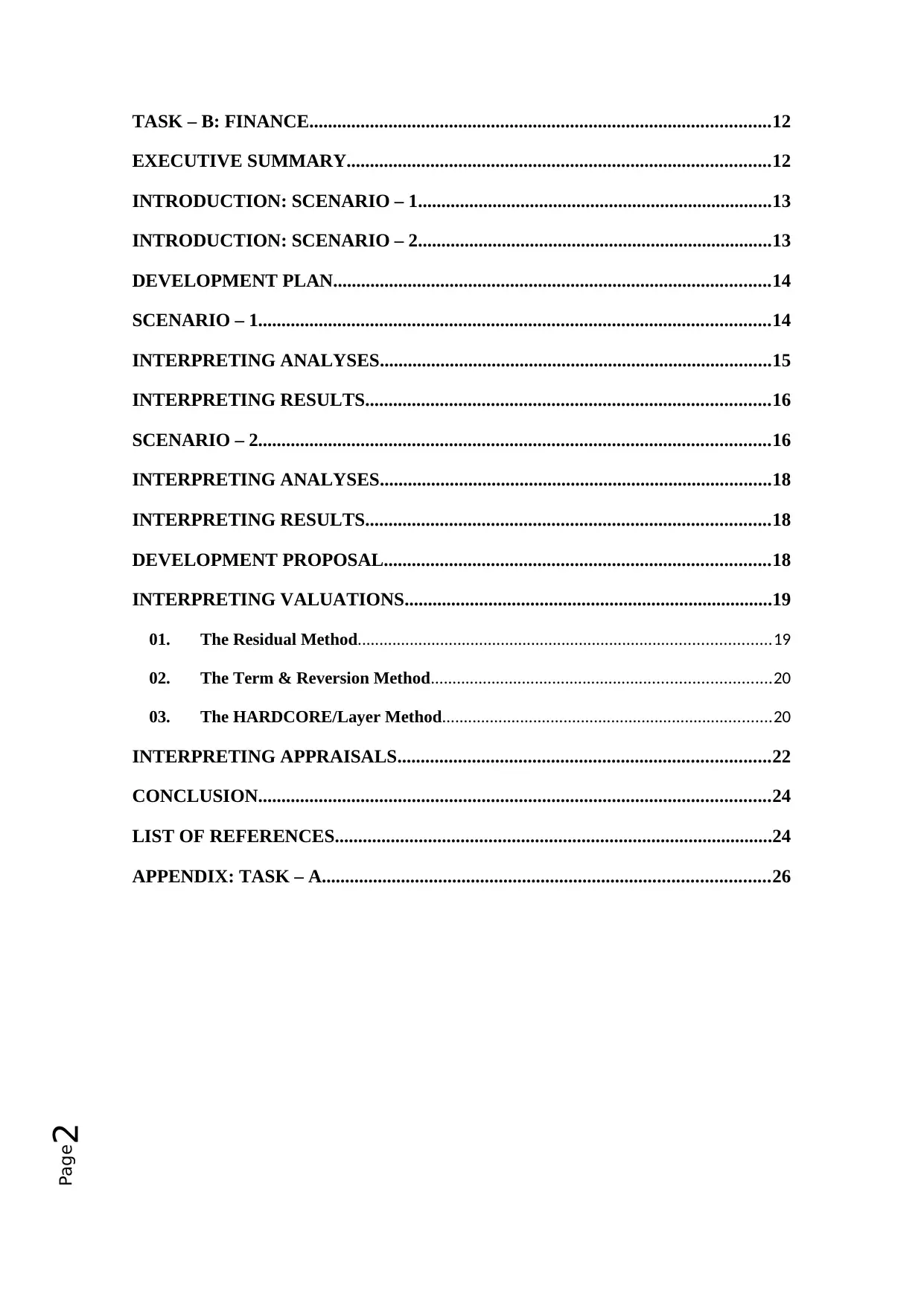
Page2
TASK – B: FINANCE...................................................................................................12
EXECUTIVE SUMMARY...........................................................................................12
INTRODUCTION: SCENARIO – 1............................................................................13
INTRODUCTION: SCENARIO – 2............................................................................13
DEVELOPMENT PLAN..............................................................................................14
SCENARIO – 1..............................................................................................................14
INTERPRETING ANALYSES....................................................................................15
INTERPRETING RESULTS.......................................................................................16
SCENARIO – 2..............................................................................................................16
INTERPRETING ANALYSES....................................................................................18
INTERPRETING RESULTS.......................................................................................18
DEVELOPMENT PROPOSAL...................................................................................18
INTERPRETING VALUATIONS...............................................................................19
01. The Residual Method...............................................................................................19
02. The Term & Reversion Method..............................................................................20
03. The HARDCORE/Layer Method............................................................................20
INTERPRETING APPRAISALS................................................................................22
CONCLUSION..............................................................................................................24
LIST OF REFERENCES..............................................................................................24
APPENDIX: TASK – A................................................................................................26
TASK – B: FINANCE...................................................................................................12
EXECUTIVE SUMMARY...........................................................................................12
INTRODUCTION: SCENARIO – 1............................................................................13
INTRODUCTION: SCENARIO – 2............................................................................13
DEVELOPMENT PLAN..............................................................................................14
SCENARIO – 1..............................................................................................................14
INTERPRETING ANALYSES....................................................................................15
INTERPRETING RESULTS.......................................................................................16
SCENARIO – 2..............................................................................................................16
INTERPRETING ANALYSES....................................................................................18
INTERPRETING RESULTS.......................................................................................18
DEVELOPMENT PROPOSAL...................................................................................18
INTERPRETING VALUATIONS...............................................................................19
01. The Residual Method...............................................................................................19
02. The Term & Reversion Method..............................................................................20
03. The HARDCORE/Layer Method............................................................................20
INTERPRETING APPRAISALS................................................................................22
CONCLUSION..............................................................................................................24
LIST OF REFERENCES..............................................................................................24
APPENDIX: TASK – A................................................................................................26
⊘ This is a preview!⊘
Do you want full access?
Subscribe today to unlock all pages.

Trusted by 1+ million students worldwide
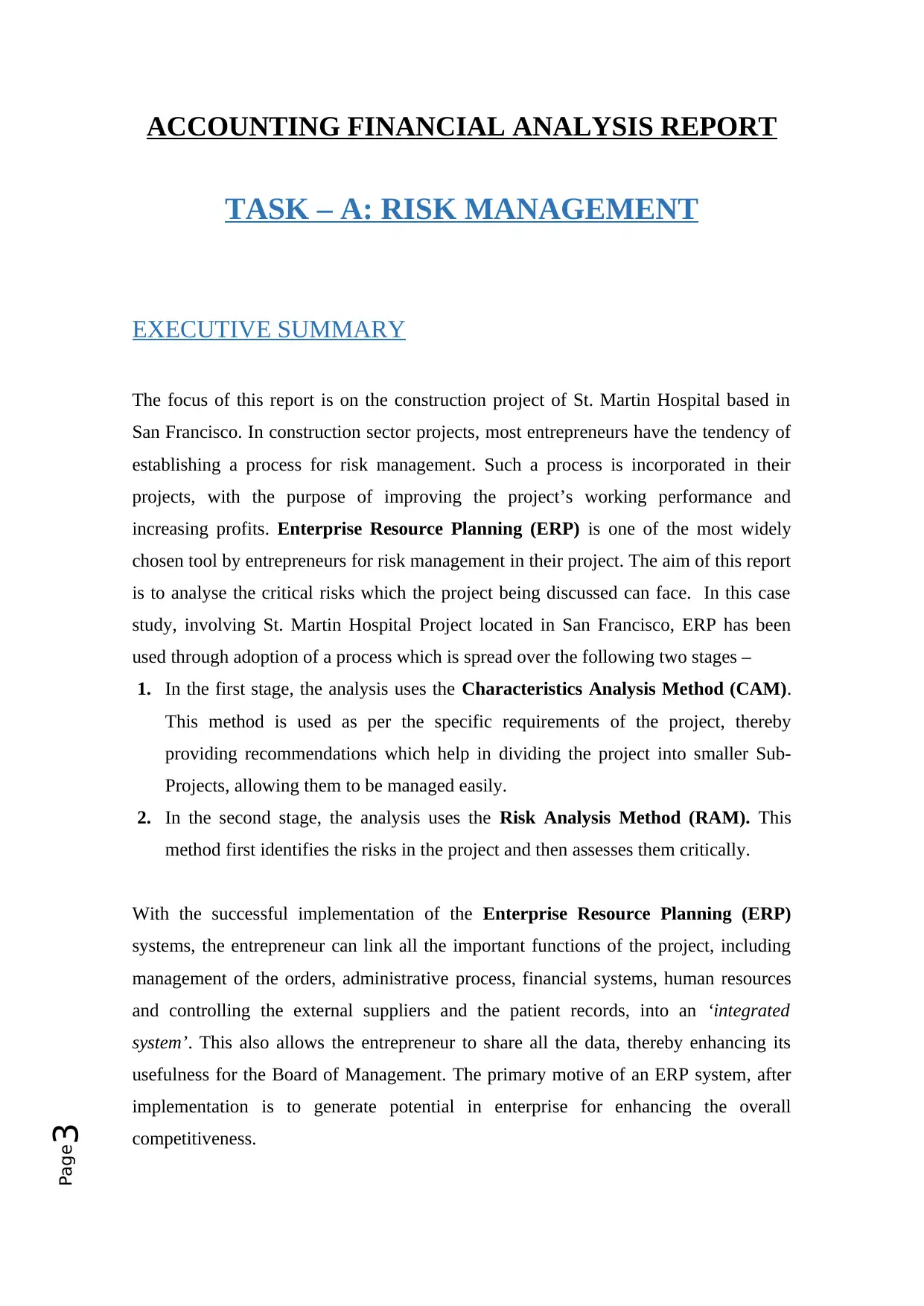
Page3
ACCOUNTING FINANCIAL ANALYSIS REPORT
TASK – A: RISK MANAGEMENT
EXECUTIVE SUMMARY
The focus of this report is on the construction project of St. Martin Hospital based in
San Francisco. In construction sector projects, most entrepreneurs have the tendency of
establishing a process for risk management. Such a process is incorporated in their
projects, with the purpose of improving the project’s working performance and
increasing profits. Enterprise Resource Planning (ERP) is one of the most widely
chosen tool by entrepreneurs for risk management in their project. The aim of this report
is to analyse the critical risks which the project being discussed can face. In this case
study, involving St. Martin Hospital Project located in San Francisco, ERP has been
used through adoption of a process which is spread over the following two stages –
1. In the first stage, the analysis uses the Characteristics Analysis Method (CAM).
This method is used as per the specific requirements of the project, thereby
providing recommendations which help in dividing the project into smaller Sub-
Projects, allowing them to be managed easily.
2. In the second stage, the analysis uses the Risk Analysis Method (RAM). This
method first identifies the risks in the project and then assesses them critically.
With the successful implementation of the Enterprise Resource Planning (ERP)
systems, the entrepreneur can link all the important functions of the project, including
management of the orders, administrative process, financial systems, human resources
and controlling the external suppliers and the patient records, into an ‘integrated
system’. This also allows the entrepreneur to share all the data, thereby enhancing its
usefulness for the Board of Management. The primary motive of an ERP system, after
implementation is to generate potential in enterprise for enhancing the overall
competitiveness.
ACCOUNTING FINANCIAL ANALYSIS REPORT
TASK – A: RISK MANAGEMENT
EXECUTIVE SUMMARY
The focus of this report is on the construction project of St. Martin Hospital based in
San Francisco. In construction sector projects, most entrepreneurs have the tendency of
establishing a process for risk management. Such a process is incorporated in their
projects, with the purpose of improving the project’s working performance and
increasing profits. Enterprise Resource Planning (ERP) is one of the most widely
chosen tool by entrepreneurs for risk management in their project. The aim of this report
is to analyse the critical risks which the project being discussed can face. In this case
study, involving St. Martin Hospital Project located in San Francisco, ERP has been
used through adoption of a process which is spread over the following two stages –
1. In the first stage, the analysis uses the Characteristics Analysis Method (CAM).
This method is used as per the specific requirements of the project, thereby
providing recommendations which help in dividing the project into smaller Sub-
Projects, allowing them to be managed easily.
2. In the second stage, the analysis uses the Risk Analysis Method (RAM). This
method first identifies the risks in the project and then assesses them critically.
With the successful implementation of the Enterprise Resource Planning (ERP)
systems, the entrepreneur can link all the important functions of the project, including
management of the orders, administrative process, financial systems, human resources
and controlling the external suppliers and the patient records, into an ‘integrated
system’. This also allows the entrepreneur to share all the data, thereby enhancing its
usefulness for the Board of Management. The primary motive of an ERP system, after
implementation is to generate potential in enterprise for enhancing the overall
competitiveness.
Paraphrase This Document
Need a fresh take? Get an instant paraphrase of this document with our AI Paraphraser
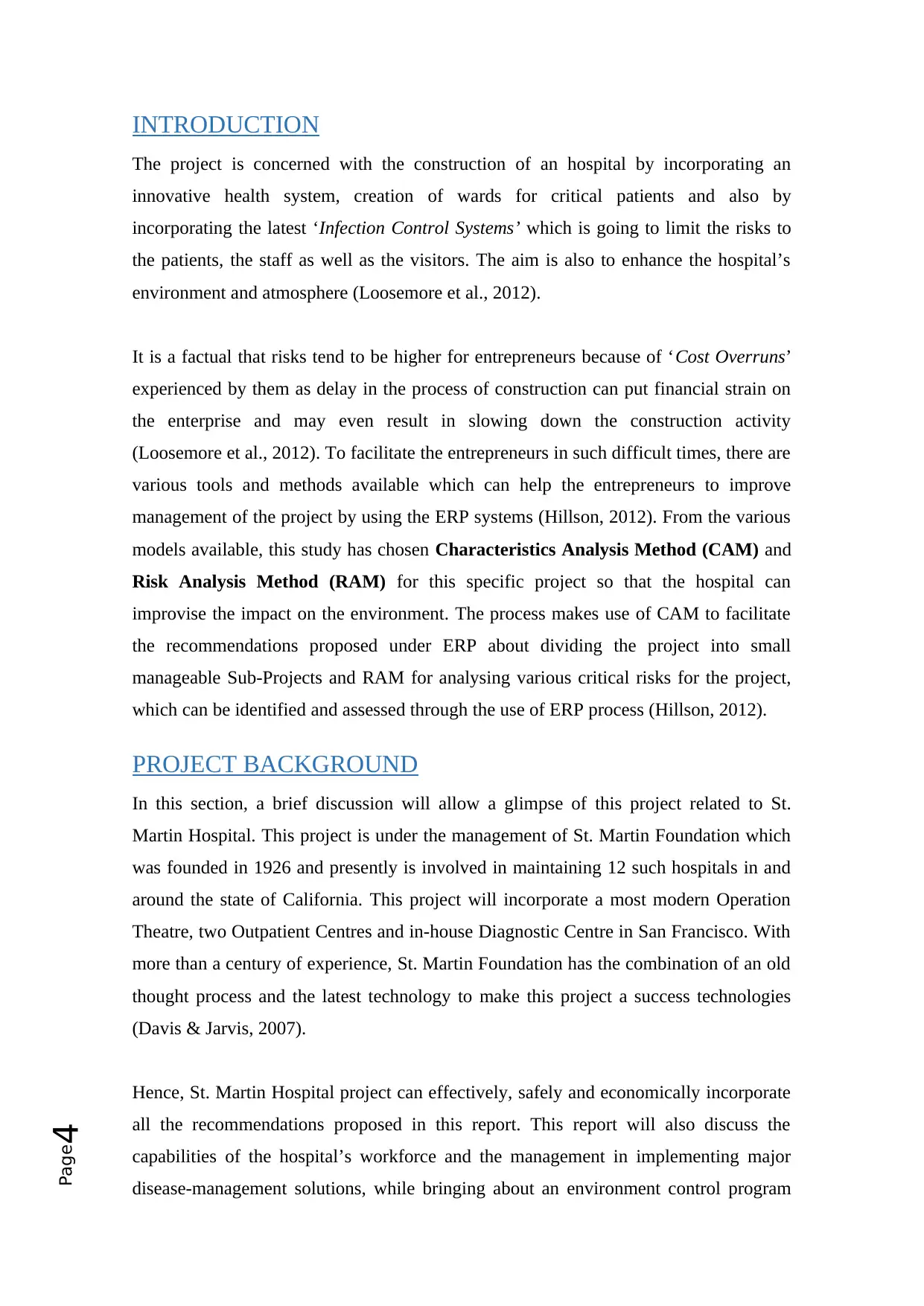
Page4
INTRODUCTION
The project is concerned with the construction of an hospital by incorporating an
innovative health system, creation of wards for critical patients and also by
incorporating the latest ‘Infection Control Systems’ which is going to limit the risks to
the patients, the staff as well as the visitors. The aim is also to enhance the hospital’s
environment and atmosphere (Loosemore et al., 2012).
It is a factual that risks tend to be higher for entrepreneurs because of ‘Cost Overruns’
experienced by them as delay in the process of construction can put financial strain on
the enterprise and may even result in slowing down the construction activity
(Loosemore et al., 2012). To facilitate the entrepreneurs in such difficult times, there are
various tools and methods available which can help the entrepreneurs to improve
management of the project by using the ERP systems (Hillson, 2012). From the various
models available, this study has chosen Characteristics Analysis Method (CAM) and
Risk Analysis Method (RAM) for this specific project so that the hospital can
improvise the impact on the environment. The process makes use of CAM to facilitate
the recommendations proposed under ERP about dividing the project into small
manageable Sub-Projects and RAM for analysing various critical risks for the project,
which can be identified and assessed through the use of ERP process (Hillson, 2012).
PROJECT BACKGROUND
In this section, a brief discussion will allow a glimpse of this project related to St.
Martin Hospital. This project is under the management of St. Martin Foundation which
was founded in 1926 and presently is involved in maintaining 12 such hospitals in and
around the state of California. This project will incorporate a most modern Operation
Theatre, two Outpatient Centres and in-house Diagnostic Centre in San Francisco. With
more than a century of experience, St. Martin Foundation has the combination of an old
thought process and the latest technology to make this project a success technologies
(Davis & Jarvis, 2007).
Hence, St. Martin Hospital project can effectively, safely and economically incorporate
all the recommendations proposed in this report. This report will also discuss the
capabilities of the hospital’s workforce and the management in implementing major
disease-management solutions, while bringing about an environment control program
INTRODUCTION
The project is concerned with the construction of an hospital by incorporating an
innovative health system, creation of wards for critical patients and also by
incorporating the latest ‘Infection Control Systems’ which is going to limit the risks to
the patients, the staff as well as the visitors. The aim is also to enhance the hospital’s
environment and atmosphere (Loosemore et al., 2012).
It is a factual that risks tend to be higher for entrepreneurs because of ‘Cost Overruns’
experienced by them as delay in the process of construction can put financial strain on
the enterprise and may even result in slowing down the construction activity
(Loosemore et al., 2012). To facilitate the entrepreneurs in such difficult times, there are
various tools and methods available which can help the entrepreneurs to improve
management of the project by using the ERP systems (Hillson, 2012). From the various
models available, this study has chosen Characteristics Analysis Method (CAM) and
Risk Analysis Method (RAM) for this specific project so that the hospital can
improvise the impact on the environment. The process makes use of CAM to facilitate
the recommendations proposed under ERP about dividing the project into small
manageable Sub-Projects and RAM for analysing various critical risks for the project,
which can be identified and assessed through the use of ERP process (Hillson, 2012).
PROJECT BACKGROUND
In this section, a brief discussion will allow a glimpse of this project related to St.
Martin Hospital. This project is under the management of St. Martin Foundation which
was founded in 1926 and presently is involved in maintaining 12 such hospitals in and
around the state of California. This project will incorporate a most modern Operation
Theatre, two Outpatient Centres and in-house Diagnostic Centre in San Francisco. With
more than a century of experience, St. Martin Foundation has the combination of an old
thought process and the latest technology to make this project a success technologies
(Davis & Jarvis, 2007).
Hence, St. Martin Hospital project can effectively, safely and economically incorporate
all the recommendations proposed in this report. This report will also discuss the
capabilities of the hospital’s workforce and the management in implementing major
disease-management solutions, while bringing about an environment control program
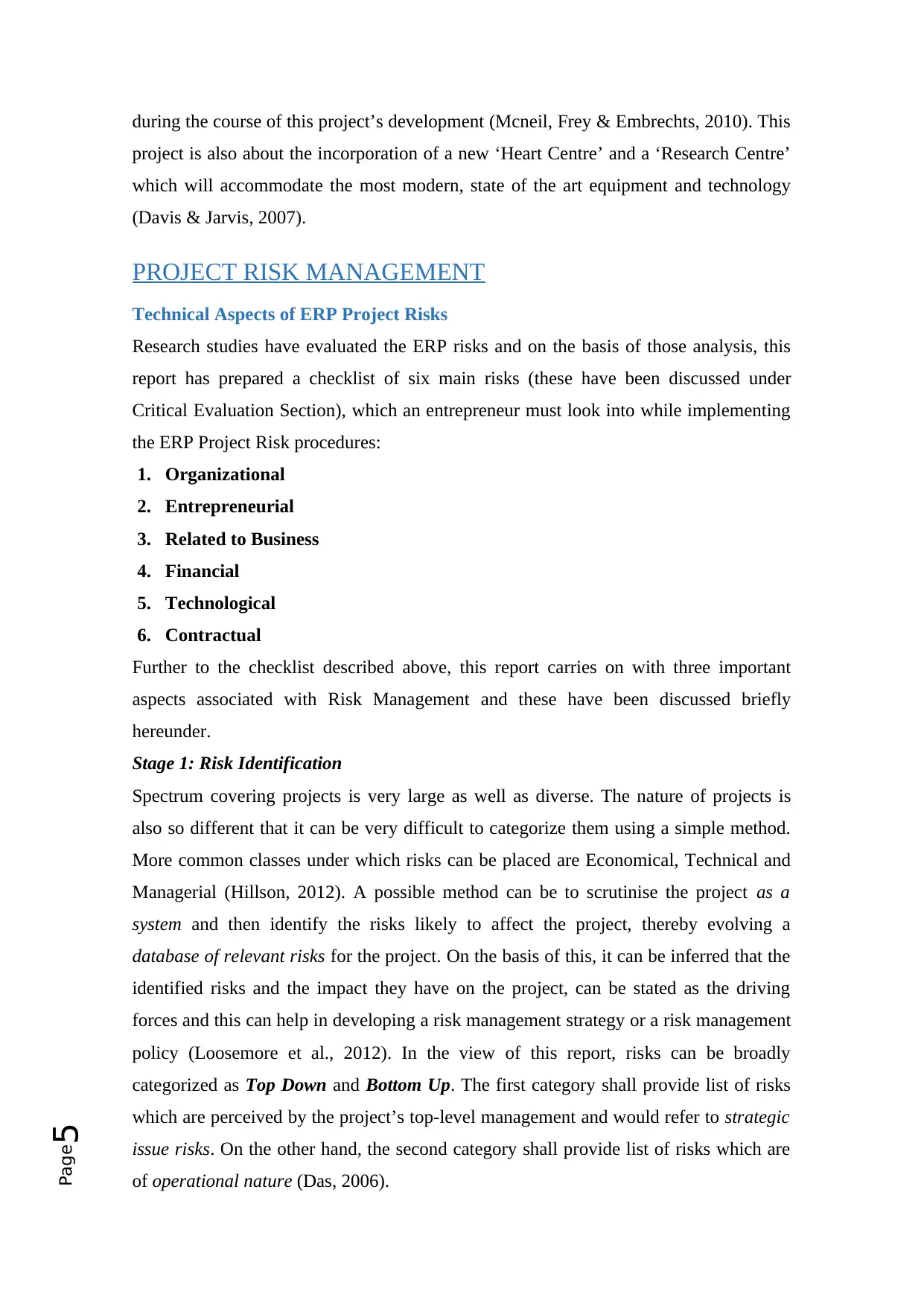
Page5
during the course of this project’s development (Mcneil, Frey & Embrechts, 2010). This
project is also about the incorporation of a new ‘Heart Centre’ and a ‘Research Centre’
which will accommodate the most modern, state of the art equipment and technology
(Davis & Jarvis, 2007).
PROJECT RISK MANAGEMENT
Technical Aspects of ERP Project Risks
Research studies have evaluated the ERP risks and on the basis of those analysis, this
report has prepared a checklist of six main risks (these have been discussed under
Critical Evaluation Section), which an entrepreneur must look into while implementing
the ERP Project Risk procedures:
1. Organizational
2. Entrepreneurial
3. Related to Business
4. Financial
5. Technological
6. Contractual
Further to the checklist described above, this report carries on with three important
aspects associated with Risk Management and these have been discussed briefly
hereunder.
Stage 1: Risk Identification
Spectrum covering projects is very large as well as diverse. The nature of projects is
also so different that it can be very difficult to categorize them using a simple method.
More common classes under which risks can be placed are Economical, Technical and
Managerial (Hillson, 2012). A possible method can be to scrutinise the project as a
system and then identify the risks likely to affect the project, thereby evolving a
database of relevant risks for the project. On the basis of this, it can be inferred that the
identified risks and the impact they have on the project, can be stated as the driving
forces and this can help in developing a risk management strategy or a risk management
policy (Loosemore et al., 2012). In the view of this report, risks can be broadly
categorized as Top Down and Bottom Up. The first category shall provide list of risks
which are perceived by the project’s top-level management and would refer to strategic
issue risks. On the other hand, the second category shall provide list of risks which are
of operational nature (Das, 2006).
during the course of this project’s development (Mcneil, Frey & Embrechts, 2010). This
project is also about the incorporation of a new ‘Heart Centre’ and a ‘Research Centre’
which will accommodate the most modern, state of the art equipment and technology
(Davis & Jarvis, 2007).
PROJECT RISK MANAGEMENT
Technical Aspects of ERP Project Risks
Research studies have evaluated the ERP risks and on the basis of those analysis, this
report has prepared a checklist of six main risks (these have been discussed under
Critical Evaluation Section), which an entrepreneur must look into while implementing
the ERP Project Risk procedures:
1. Organizational
2. Entrepreneurial
3. Related to Business
4. Financial
5. Technological
6. Contractual
Further to the checklist described above, this report carries on with three important
aspects associated with Risk Management and these have been discussed briefly
hereunder.
Stage 1: Risk Identification
Spectrum covering projects is very large as well as diverse. The nature of projects is
also so different that it can be very difficult to categorize them using a simple method.
More common classes under which risks can be placed are Economical, Technical and
Managerial (Hillson, 2012). A possible method can be to scrutinise the project as a
system and then identify the risks likely to affect the project, thereby evolving a
database of relevant risks for the project. On the basis of this, it can be inferred that the
identified risks and the impact they have on the project, can be stated as the driving
forces and this can help in developing a risk management strategy or a risk management
policy (Loosemore et al., 2012). In the view of this report, risks can be broadly
categorized as Top Down and Bottom Up. The first category shall provide list of risks
which are perceived by the project’s top-level management and would refer to strategic
issue risks. On the other hand, the second category shall provide list of risks which are
of operational nature (Das, 2006).
⊘ This is a preview!⊘
Do you want full access?
Subscribe today to unlock all pages.

Trusted by 1+ million students worldwide
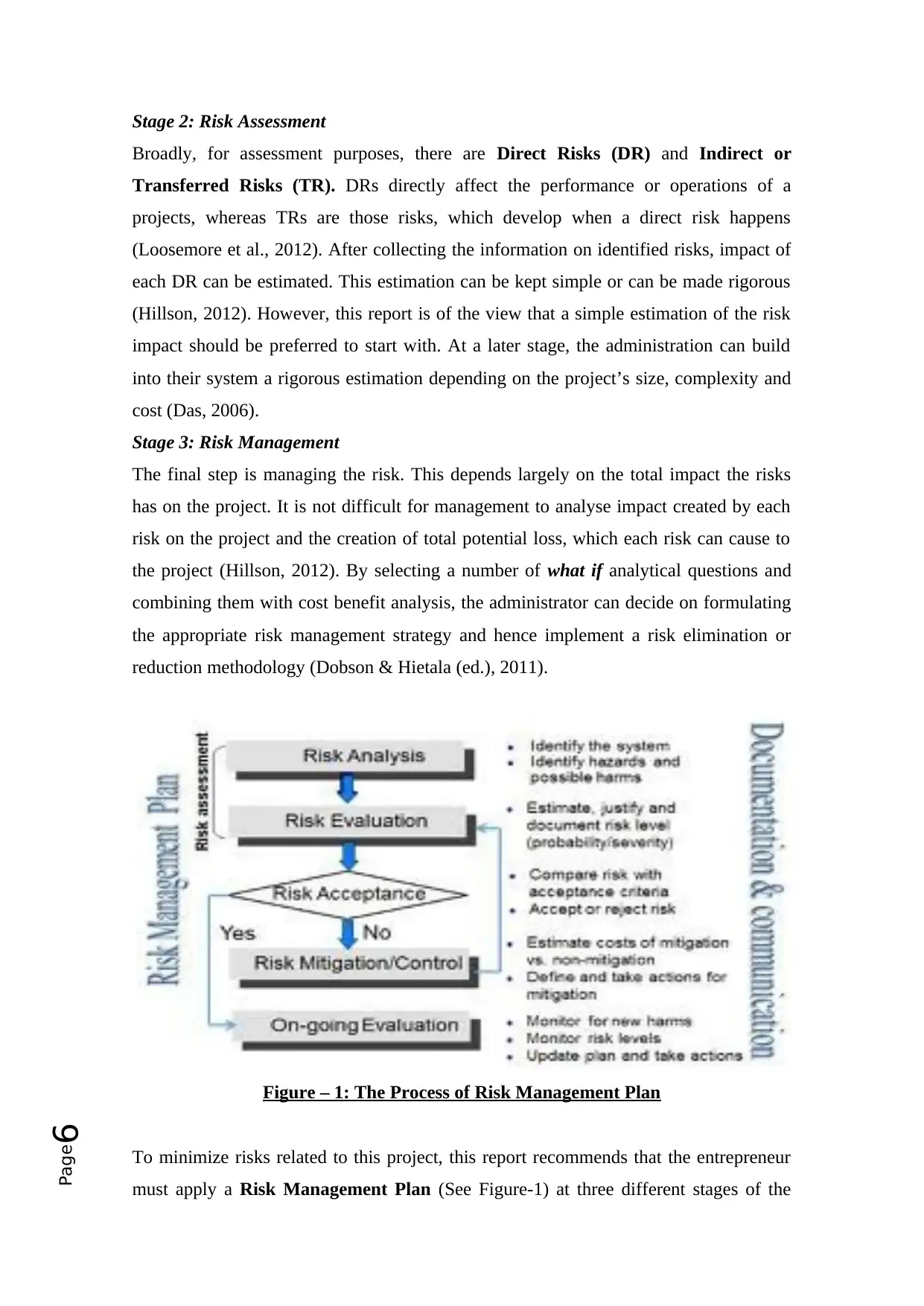
Page6
Stage 2: Risk Assessment
Broadly, for assessment purposes, there are Direct Risks (DR) and Indirect or
Transferred Risks (TR). DRs directly affect the performance or operations of a
projects, whereas TRs are those risks, which develop when a direct risk happens
(Loosemore et al., 2012). After collecting the information on identified risks, impact of
each DR can be estimated. This estimation can be kept simple or can be made rigorous
(Hillson, 2012). However, this report is of the view that a simple estimation of the risk
impact should be preferred to start with. At a later stage, the administration can build
into their system a rigorous estimation depending on the project’s size, complexity and
cost (Das, 2006).
Stage 3: Risk Management
The final step is managing the risk. This depends largely on the total impact the risks
has on the project. It is not difficult for management to analyse impact created by each
risk on the project and the creation of total potential loss, which each risk can cause to
the project (Hillson, 2012). By selecting a number of what if analytical questions and
combining them with cost benefit analysis, the administrator can decide on formulating
the appropriate risk management strategy and hence implement a risk elimination or
reduction methodology (Dobson & Hietala (ed.), 2011).
Figure – 1: The Process of Risk Management Plan
To minimize risks related to this project, this report recommends that the entrepreneur
must apply a Risk Management Plan (See Figure-1) at three different stages of the
Stage 2: Risk Assessment
Broadly, for assessment purposes, there are Direct Risks (DR) and Indirect or
Transferred Risks (TR). DRs directly affect the performance or operations of a
projects, whereas TRs are those risks, which develop when a direct risk happens
(Loosemore et al., 2012). After collecting the information on identified risks, impact of
each DR can be estimated. This estimation can be kept simple or can be made rigorous
(Hillson, 2012). However, this report is of the view that a simple estimation of the risk
impact should be preferred to start with. At a later stage, the administration can build
into their system a rigorous estimation depending on the project’s size, complexity and
cost (Das, 2006).
Stage 3: Risk Management
The final step is managing the risk. This depends largely on the total impact the risks
has on the project. It is not difficult for management to analyse impact created by each
risk on the project and the creation of total potential loss, which each risk can cause to
the project (Hillson, 2012). By selecting a number of what if analytical questions and
combining them with cost benefit analysis, the administrator can decide on formulating
the appropriate risk management strategy and hence implement a risk elimination or
reduction methodology (Dobson & Hietala (ed.), 2011).
Figure – 1: The Process of Risk Management Plan
To minimize risks related to this project, this report recommends that the entrepreneur
must apply a Risk Management Plan (See Figure-1) at three different stages of the
Paraphrase This Document
Need a fresh take? Get an instant paraphrase of this document with our AI Paraphraser
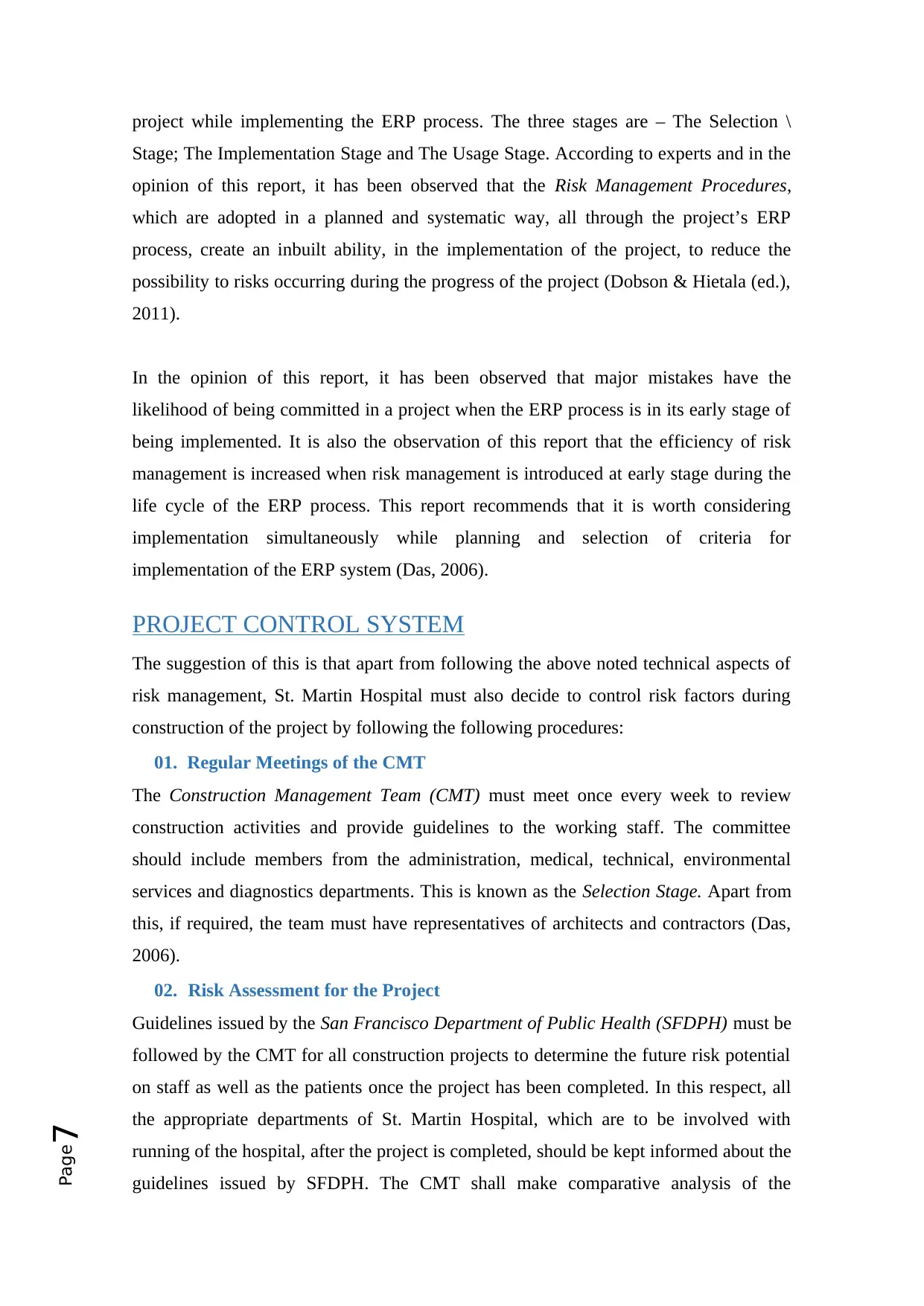
Page7
project while implementing the ERP process. The three stages are – The Selection \
Stage; The Implementation Stage and The Usage Stage. According to experts and in the
opinion of this report, it has been observed that the Risk Management Procedures,
which are adopted in a planned and systematic way, all through the project’s ERP
process, create an inbuilt ability, in the implementation of the project, to reduce the
possibility to risks occurring during the progress of the project (Dobson & Hietala (ed.),
2011).
In the opinion of this report, it has been observed that major mistakes have the
likelihood of being committed in a project when the ERP process is in its early stage of
being implemented. It is also the observation of this report that the efficiency of risk
management is increased when risk management is introduced at early stage during the
life cycle of the ERP process. This report recommends that it is worth considering
implementation simultaneously while planning and selection of criteria for
implementation of the ERP system (Das, 2006).
PROJECT CONTROL SYSTEM
The suggestion of this is that apart from following the above noted technical aspects of
risk management, St. Martin Hospital must also decide to control risk factors during
construction of the project by following the following procedures:
01. Regular Meetings of the CMT
The Construction Management Team (CMT) must meet once every week to review
construction activities and provide guidelines to the working staff. The committee
should include members from the administration, medical, technical, environmental
services and diagnostics departments. This is known as the Selection Stage. Apart from
this, if required, the team must have representatives of architects and contractors (Das,
2006).
02. Risk Assessment for the Project
Guidelines issued by the San Francisco Department of Public Health (SFDPH) must be
followed by the CMT for all construction projects to determine the future risk potential
on staff as well as the patients once the project has been completed. In this respect, all
the appropriate departments of St. Martin Hospital, which are to be involved with
running of the hospital, after the project is completed, should be kept informed about the
guidelines issued by SFDPH. The CMT shall make comparative analysis of the
project while implementing the ERP process. The three stages are – The Selection \
Stage; The Implementation Stage and The Usage Stage. According to experts and in the
opinion of this report, it has been observed that the Risk Management Procedures,
which are adopted in a planned and systematic way, all through the project’s ERP
process, create an inbuilt ability, in the implementation of the project, to reduce the
possibility to risks occurring during the progress of the project (Dobson & Hietala (ed.),
2011).
In the opinion of this report, it has been observed that major mistakes have the
likelihood of being committed in a project when the ERP process is in its early stage of
being implemented. It is also the observation of this report that the efficiency of risk
management is increased when risk management is introduced at early stage during the
life cycle of the ERP process. This report recommends that it is worth considering
implementation simultaneously while planning and selection of criteria for
implementation of the ERP system (Das, 2006).
PROJECT CONTROL SYSTEM
The suggestion of this is that apart from following the above noted technical aspects of
risk management, St. Martin Hospital must also decide to control risk factors during
construction of the project by following the following procedures:
01. Regular Meetings of the CMT
The Construction Management Team (CMT) must meet once every week to review
construction activities and provide guidelines to the working staff. The committee
should include members from the administration, medical, technical, environmental
services and diagnostics departments. This is known as the Selection Stage. Apart from
this, if required, the team must have representatives of architects and contractors (Das,
2006).
02. Risk Assessment for the Project
Guidelines issued by the San Francisco Department of Public Health (SFDPH) must be
followed by the CMT for all construction projects to determine the future risk potential
on staff as well as the patients once the project has been completed. In this respect, all
the appropriate departments of St. Martin Hospital, which are to be involved with
running of the hospital, after the project is completed, should be kept informed about the
guidelines issued by SFDPH. The CMT shall make comparative analysis of the
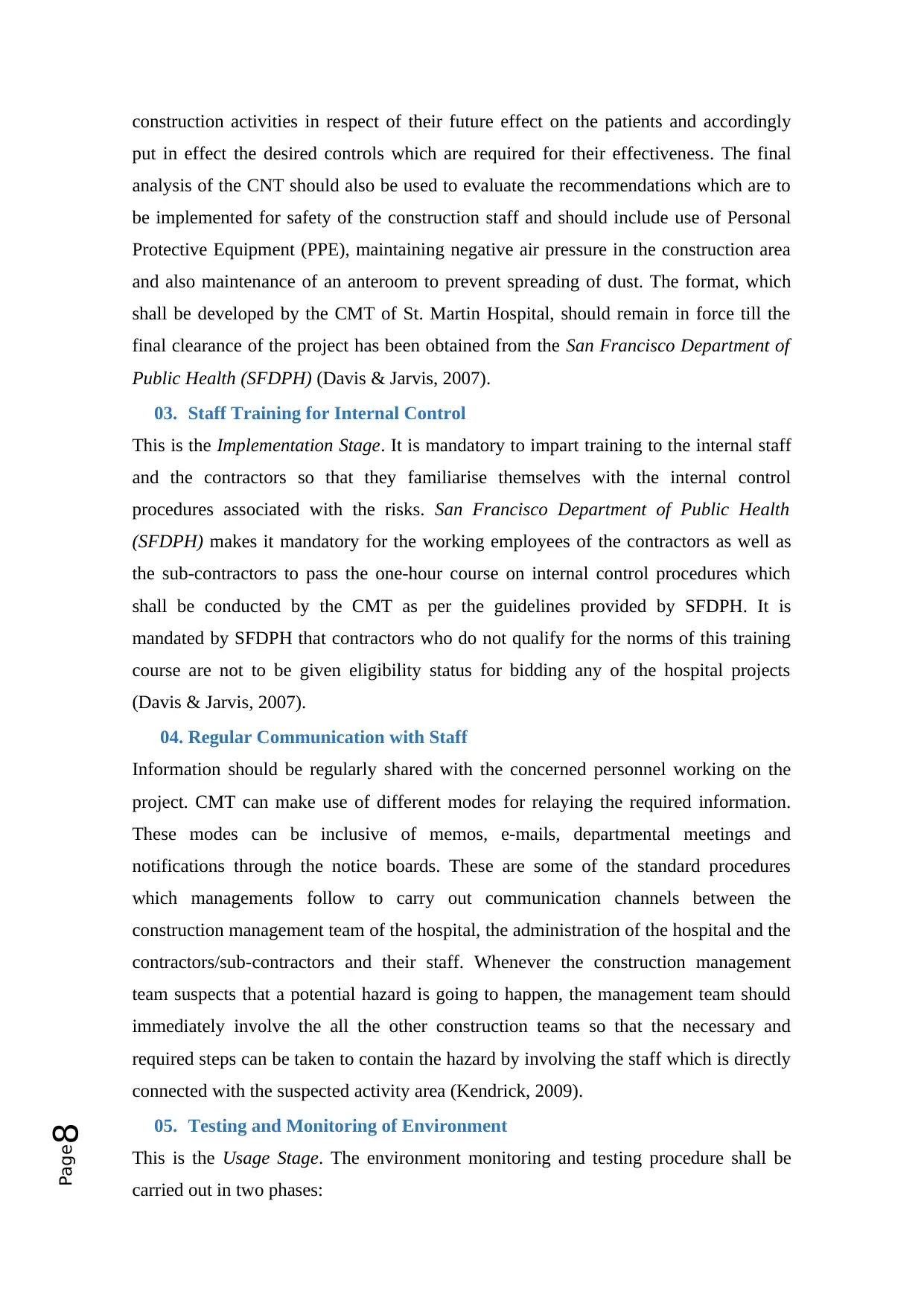
Page8
construction activities in respect of their future effect on the patients and accordingly
put in effect the desired controls which are required for their effectiveness. The final
analysis of the CNT should also be used to evaluate the recommendations which are to
be implemented for safety of the construction staff and should include use of Personal
Protective Equipment (PPE), maintaining negative air pressure in the construction area
and also maintenance of an anteroom to prevent spreading of dust. The format, which
shall be developed by the CMT of St. Martin Hospital, should remain in force till the
final clearance of the project has been obtained from the San Francisco Department of
Public Health (SFDPH) (Davis & Jarvis, 2007).
03. Staff Training for Internal Control
This is the Implementation Stage. It is mandatory to impart training to the internal staff
and the contractors so that they familiarise themselves with the internal control
procedures associated with the risks. San Francisco Department of Public Health
(SFDPH) makes it mandatory for the working employees of the contractors as well as
the sub-contractors to pass the one-hour course on internal control procedures which
shall be conducted by the CMT as per the guidelines provided by SFDPH. It is
mandated by SFDPH that contractors who do not qualify for the norms of this training
course are not to be given eligibility status for bidding any of the hospital projects
(Davis & Jarvis, 2007).
04. Regular Communication with Staff
Information should be regularly shared with the concerned personnel working on the
project. CMT can make use of different modes for relaying the required information.
These modes can be inclusive of memos, e-mails, departmental meetings and
notifications through the notice boards. These are some of the standard procedures
which managements follow to carry out communication channels between the
construction management team of the hospital, the administration of the hospital and the
contractors/sub-contractors and their staff. Whenever the construction management
team suspects that a potential hazard is going to happen, the management team should
immediately involve the all the other construction teams so that the necessary and
required steps can be taken to contain the hazard by involving the staff which is directly
connected with the suspected activity area (Kendrick, 2009).
05. Testing and Monitoring of Environment
This is the Usage Stage. The environment monitoring and testing procedure shall be
carried out in two phases:
construction activities in respect of their future effect on the patients and accordingly
put in effect the desired controls which are required for their effectiveness. The final
analysis of the CNT should also be used to evaluate the recommendations which are to
be implemented for safety of the construction staff and should include use of Personal
Protective Equipment (PPE), maintaining negative air pressure in the construction area
and also maintenance of an anteroom to prevent spreading of dust. The format, which
shall be developed by the CMT of St. Martin Hospital, should remain in force till the
final clearance of the project has been obtained from the San Francisco Department of
Public Health (SFDPH) (Davis & Jarvis, 2007).
03. Staff Training for Internal Control
This is the Implementation Stage. It is mandatory to impart training to the internal staff
and the contractors so that they familiarise themselves with the internal control
procedures associated with the risks. San Francisco Department of Public Health
(SFDPH) makes it mandatory for the working employees of the contractors as well as
the sub-contractors to pass the one-hour course on internal control procedures which
shall be conducted by the CMT as per the guidelines provided by SFDPH. It is
mandated by SFDPH that contractors who do not qualify for the norms of this training
course are not to be given eligibility status for bidding any of the hospital projects
(Davis & Jarvis, 2007).
04. Regular Communication with Staff
Information should be regularly shared with the concerned personnel working on the
project. CMT can make use of different modes for relaying the required information.
These modes can be inclusive of memos, e-mails, departmental meetings and
notifications through the notice boards. These are some of the standard procedures
which managements follow to carry out communication channels between the
construction management team of the hospital, the administration of the hospital and the
contractors/sub-contractors and their staff. Whenever the construction management
team suspects that a potential hazard is going to happen, the management team should
immediately involve the all the other construction teams so that the necessary and
required steps can be taken to contain the hazard by involving the staff which is directly
connected with the suspected activity area (Kendrick, 2009).
05. Testing and Monitoring of Environment
This is the Usage Stage. The environment monitoring and testing procedure shall be
carried out in two phases:
⊘ This is a preview!⊘
Do you want full access?
Subscribe today to unlock all pages.

Trusted by 1+ million students worldwide
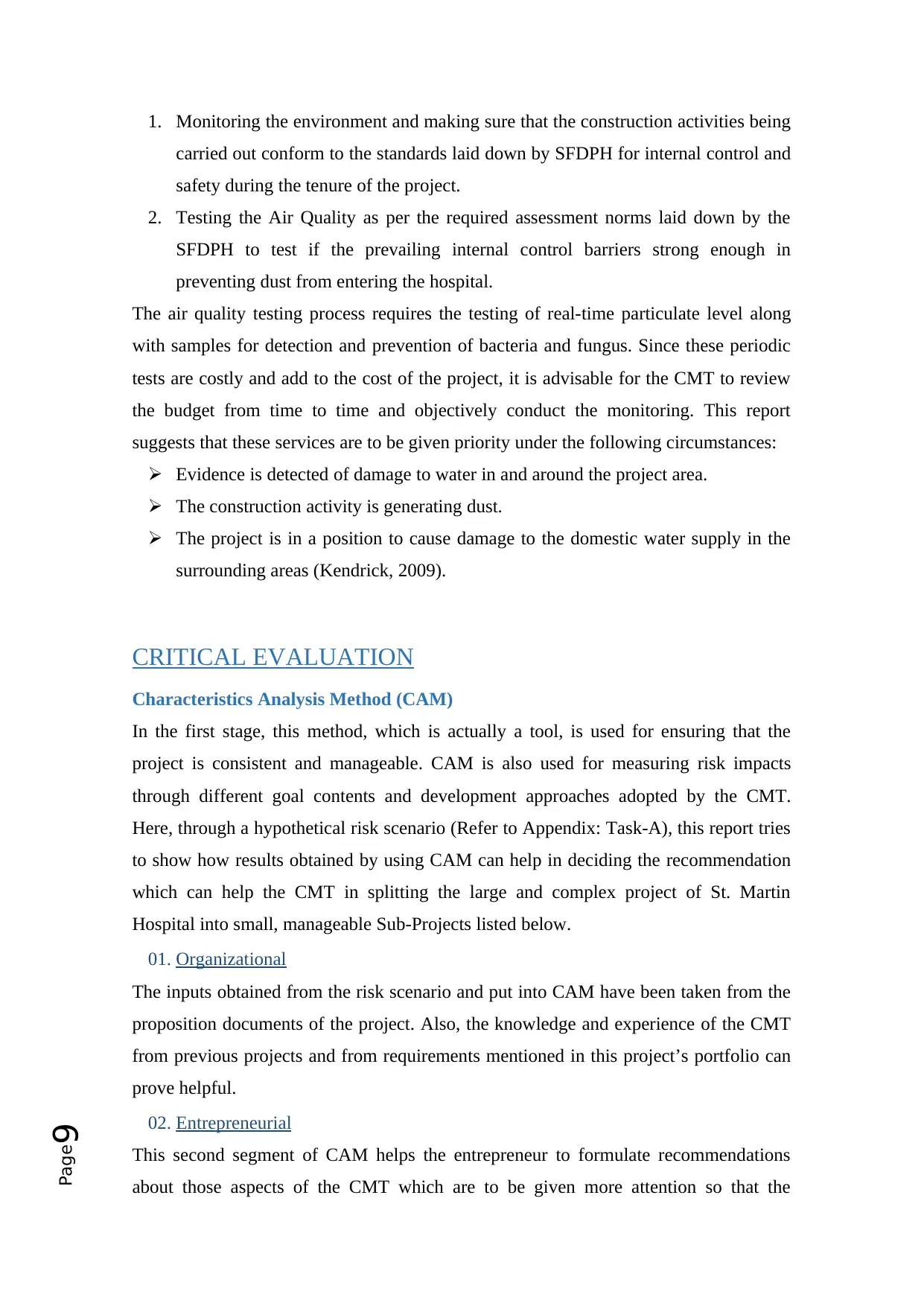
Page9
1. Monitoring the environment and making sure that the construction activities being
carried out conform to the standards laid down by SFDPH for internal control and
safety during the tenure of the project.
2. Testing the Air Quality as per the required assessment norms laid down by the
SFDPH to test if the prevailing internal control barriers strong enough in
preventing dust from entering the hospital.
The air quality testing process requires the testing of real-time particulate level along
with samples for detection and prevention of bacteria and fungus. Since these periodic
tests are costly and add to the cost of the project, it is advisable for the CMT to review
the budget from time to time and objectively conduct the monitoring. This report
suggests that these services are to be given priority under the following circumstances:
Evidence is detected of damage to water in and around the project area.
The construction activity is generating dust.
The project is in a position to cause damage to the domestic water supply in the
surrounding areas (Kendrick, 2009).
CRITICAL EVALUATION
Characteristics Analysis Method (CAM)
In the first stage, this method, which is actually a tool, is used for ensuring that the
project is consistent and manageable. CAM is also used for measuring risk impacts
through different goal contents and development approaches adopted by the CMT.
Here, through a hypothetical risk scenario (Refer to Appendix: Task-A), this report tries
to show how results obtained by using CAM can help in deciding the recommendation
which can help the CMT in splitting the large and complex project of St. Martin
Hospital into small, manageable Sub-Projects listed below.
01. Organizational
The inputs obtained from the risk scenario and put into CAM have been taken from the
proposition documents of the project. Also, the knowledge and experience of the CMT
from previous projects and from requirements mentioned in this project’s portfolio can
prove helpful.
02. Entrepreneurial
This second segment of CAM helps the entrepreneur to formulate recommendations
about those aspects of the CMT which are to be given more attention so that the
1. Monitoring the environment and making sure that the construction activities being
carried out conform to the standards laid down by SFDPH for internal control and
safety during the tenure of the project.
2. Testing the Air Quality as per the required assessment norms laid down by the
SFDPH to test if the prevailing internal control barriers strong enough in
preventing dust from entering the hospital.
The air quality testing process requires the testing of real-time particulate level along
with samples for detection and prevention of bacteria and fungus. Since these periodic
tests are costly and add to the cost of the project, it is advisable for the CMT to review
the budget from time to time and objectively conduct the monitoring. This report
suggests that these services are to be given priority under the following circumstances:
Evidence is detected of damage to water in and around the project area.
The construction activity is generating dust.
The project is in a position to cause damage to the domestic water supply in the
surrounding areas (Kendrick, 2009).
CRITICAL EVALUATION
Characteristics Analysis Method (CAM)
In the first stage, this method, which is actually a tool, is used for ensuring that the
project is consistent and manageable. CAM is also used for measuring risk impacts
through different goal contents and development approaches adopted by the CMT.
Here, through a hypothetical risk scenario (Refer to Appendix: Task-A), this report tries
to show how results obtained by using CAM can help in deciding the recommendation
which can help the CMT in splitting the large and complex project of St. Martin
Hospital into small, manageable Sub-Projects listed below.
01. Organizational
The inputs obtained from the risk scenario and put into CAM have been taken from the
proposition documents of the project. Also, the knowledge and experience of the CMT
from previous projects and from requirements mentioned in this project’s portfolio can
prove helpful.
02. Entrepreneurial
This second segment of CAM helps the entrepreneur to formulate recommendations
about those aspects of the CMT which are to be given more attention so that the
Paraphrase This Document
Need a fresh take? Get an instant paraphrase of this document with our AI Paraphraser
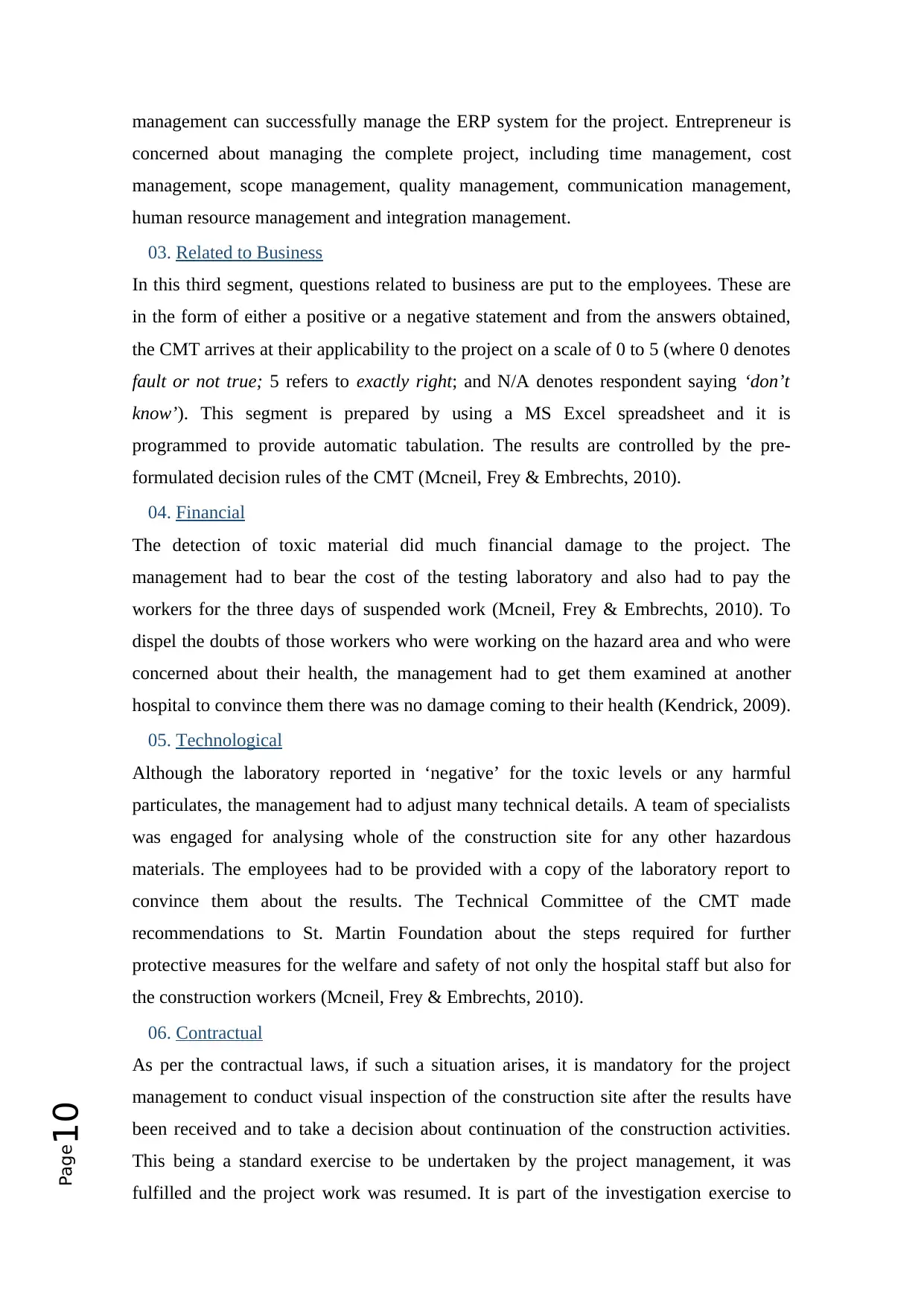
Page10
management can successfully manage the ERP system for the project. Entrepreneur is
concerned about managing the complete project, including time management, cost
management, scope management, quality management, communication management,
human resource management and integration management.
03. Related to Business
In this third segment, questions related to business are put to the employees. These are
in the form of either a positive or a negative statement and from the answers obtained,
the CMT arrives at their applicability to the project on a scale of 0 to 5 (where 0 denotes
fault or not true; 5 refers to exactly right; and N/A denotes respondent saying ‘don’t
know’). This segment is prepared by using a MS Excel spreadsheet and it is
programmed to provide automatic tabulation. The results are controlled by the pre-
formulated decision rules of the CMT (Mcneil, Frey & Embrechts, 2010).
04. Financial
The detection of toxic material did much financial damage to the project. The
management had to bear the cost of the testing laboratory and also had to pay the
workers for the three days of suspended work (Mcneil, Frey & Embrechts, 2010). To
dispel the doubts of those workers who were working on the hazard area and who were
concerned about their health, the management had to get them examined at another
hospital to convince them there was no damage coming to their health (Kendrick, 2009).
05. Technological
Although the laboratory reported in ‘negative’ for the toxic levels or any harmful
particulates, the management had to adjust many technical details. A team of specialists
was engaged for analysing whole of the construction site for any other hazardous
materials. The employees had to be provided with a copy of the laboratory report to
convince them about the results. The Technical Committee of the CMT made
recommendations to St. Martin Foundation about the steps required for further
protective measures for the welfare and safety of not only the hospital staff but also for
the construction workers (Mcneil, Frey & Embrechts, 2010).
06. Contractual
As per the contractual laws, if such a situation arises, it is mandatory for the project
management to conduct visual inspection of the construction site after the results have
been received and to take a decision about continuation of the construction activities.
This being a standard exercise to be undertaken by the project management, it was
fulfilled and the project work was resumed. It is part of the investigation exercise to
management can successfully manage the ERP system for the project. Entrepreneur is
concerned about managing the complete project, including time management, cost
management, scope management, quality management, communication management,
human resource management and integration management.
03. Related to Business
In this third segment, questions related to business are put to the employees. These are
in the form of either a positive or a negative statement and from the answers obtained,
the CMT arrives at their applicability to the project on a scale of 0 to 5 (where 0 denotes
fault or not true; 5 refers to exactly right; and N/A denotes respondent saying ‘don’t
know’). This segment is prepared by using a MS Excel spreadsheet and it is
programmed to provide automatic tabulation. The results are controlled by the pre-
formulated decision rules of the CMT (Mcneil, Frey & Embrechts, 2010).
04. Financial
The detection of toxic material did much financial damage to the project. The
management had to bear the cost of the testing laboratory and also had to pay the
workers for the three days of suspended work (Mcneil, Frey & Embrechts, 2010). To
dispel the doubts of those workers who were working on the hazard area and who were
concerned about their health, the management had to get them examined at another
hospital to convince them there was no damage coming to their health (Kendrick, 2009).
05. Technological
Although the laboratory reported in ‘negative’ for the toxic levels or any harmful
particulates, the management had to adjust many technical details. A team of specialists
was engaged for analysing whole of the construction site for any other hazardous
materials. The employees had to be provided with a copy of the laboratory report to
convince them about the results. The Technical Committee of the CMT made
recommendations to St. Martin Foundation about the steps required for further
protective measures for the welfare and safety of not only the hospital staff but also for
the construction workers (Mcneil, Frey & Embrechts, 2010).
06. Contractual
As per the contractual laws, if such a situation arises, it is mandatory for the project
management to conduct visual inspection of the construction site after the results have
been received and to take a decision about continuation of the construction activities.
This being a standard exercise to be undertaken by the project management, it was
fulfilled and the project work was resumed. It is part of the investigation exercise to
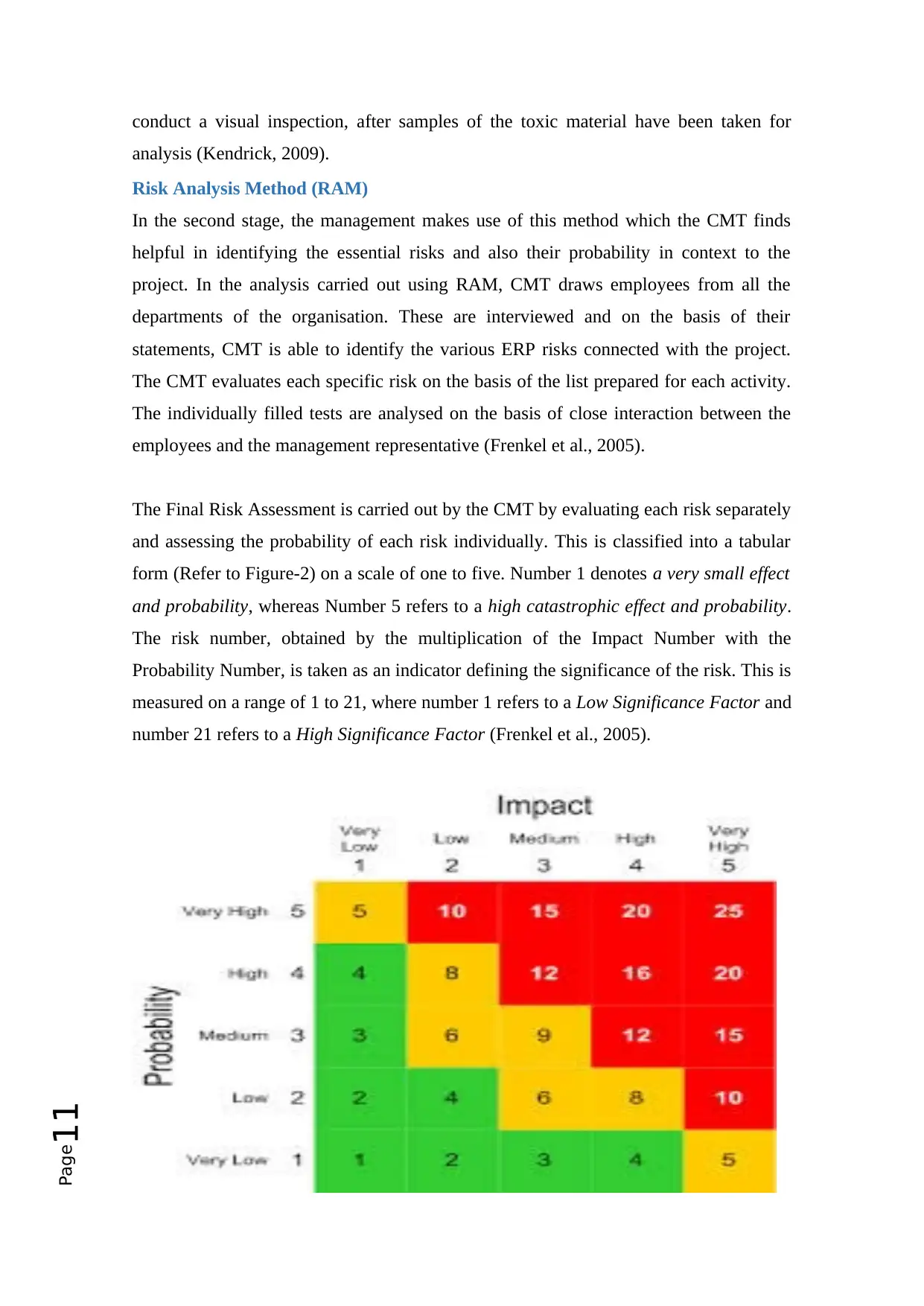
Page11
conduct a visual inspection, after samples of the toxic material have been taken for
analysis (Kendrick, 2009).
Risk Analysis Method (RAM)
In the second stage, the management makes use of this method which the CMT finds
helpful in identifying the essential risks and also their probability in context to the
project. In the analysis carried out using RAM, CMT draws employees from all the
departments of the organisation. These are interviewed and on the basis of their
statements, CMT is able to identify the various ERP risks connected with the project.
The CMT evaluates each specific risk on the basis of the list prepared for each activity.
The individually filled tests are analysed on the basis of close interaction between the
employees and the management representative (Frenkel et al., 2005).
The Final Risk Assessment is carried out by the CMT by evaluating each risk separately
and assessing the probability of each risk individually. This is classified into a tabular
form (Refer to Figure-2) on a scale of one to five. Number 1 denotes a very small effect
and probability, whereas Number 5 refers to a high catastrophic effect and probability.
The risk number, obtained by the multiplication of the Impact Number with the
Probability Number, is taken as an indicator defining the significance of the risk. This is
measured on a range of 1 to 21, where number 1 refers to a Low Significance Factor and
number 21 refers to a High Significance Factor (Frenkel et al., 2005).
conduct a visual inspection, after samples of the toxic material have been taken for
analysis (Kendrick, 2009).
Risk Analysis Method (RAM)
In the second stage, the management makes use of this method which the CMT finds
helpful in identifying the essential risks and also their probability in context to the
project. In the analysis carried out using RAM, CMT draws employees from all the
departments of the organisation. These are interviewed and on the basis of their
statements, CMT is able to identify the various ERP risks connected with the project.
The CMT evaluates each specific risk on the basis of the list prepared for each activity.
The individually filled tests are analysed on the basis of close interaction between the
employees and the management representative (Frenkel et al., 2005).
The Final Risk Assessment is carried out by the CMT by evaluating each risk separately
and assessing the probability of each risk individually. This is classified into a tabular
form (Refer to Figure-2) on a scale of one to five. Number 1 denotes a very small effect
and probability, whereas Number 5 refers to a high catastrophic effect and probability.
The risk number, obtained by the multiplication of the Impact Number with the
Probability Number, is taken as an indicator defining the significance of the risk. This is
measured on a range of 1 to 21, where number 1 refers to a Low Significance Factor and
number 21 refers to a High Significance Factor (Frenkel et al., 2005).
⊘ This is a preview!⊘
Do you want full access?
Subscribe today to unlock all pages.

Trusted by 1+ million students worldwide
1 out of 28
Related Documents
Your All-in-One AI-Powered Toolkit for Academic Success.
+13062052269
info@desklib.com
Available 24*7 on WhatsApp / Email
![[object Object]](/_next/static/media/star-bottom.7253800d.svg)
Unlock your academic potential
Copyright © 2020–2025 A2Z Services. All Rights Reserved. Developed and managed by ZUCOL.




